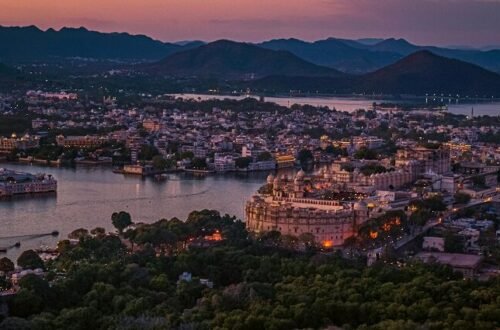Set against the picturesque backdrop of Lake Pichola, Bagore Ki Haveli is one of Udaipur’s most captivating cultural landmarks. Steeped in history and architectural elegance, this 18th-century haveli offers a deep dive into Mewar’s royal heritage, lifestyle, and performing arts. Whether you are embarking on a full Udaipur Sightseeing Tour or just exploring the city’s old quarters, Bagore Ki Haveli is a destination you simply cannot miss.
This guide will walk you through the haveli’s main attractions, stunning architectural elements, and its world-famous cultural performances — and how best to get there, whether you’re arriving by an Udaipur Airport Taxi or prefer to book taxi services in Udaipur for a day of exploring.
A Royal Past: The History of Bagore Ki Haveli
Built in the 18th century by Amar Chand Badwa, the Prime Minister of Mewar, Bagore Ki Haveli served as a residence for royal officials and nobles. Located at Gangaur Ghat on the waterfront of Lake Pichola, the haveli was later taken over by members of the royal family of Bagore.
After decades of neglect, the haveli was restored by the West Zone Cultural Centre, turning it into a living museum that now houses over 100 rooms, each rich in historical artifacts, traditional decor, and cultural displays.
Attractions Inside Bagore Ki Haveli
Bagore Ki Haveli is more than just an old mansion. It’s a cultural archive of Udaipur’s regal past. As you walk through its intricately designed corridors and courtyards, you’ll discover a series of well-preserved exhibits and local treasures.
1. The Royal Rooms
These rooms are restored with authentic furniture and household items from the Mewar dynasty, offering a peek into the royal lifestyle. Bedrooms, dressing rooms, bathrooms, and living areas all retain their original charm, with delicate murals, traditional window lattices (jharokhas), and vintage mirrors.
2. The Puppet Museum
A delightful area for both kids and adults, this section showcases an impressive collection of traditional Rajasthani puppets. Puppetry has deep roots in Rajasthani folk culture, and the museum highlights its evolution over the years.
3. Costume and Turban Gallery
Admire royal costumes, jewelry, and an elaborate turban collection that reflects the diversity of Rajasthani regions and communities. Each turban style symbolizes different social statuses, regions, and traditions.
4. Artifacts and Household Exhibits
You’ll also find antique games, musical instruments, utensils, and tools that reflect the everyday life of the Mewar nobility.
The Architecture: Rajput Grandeur in Every Detail
Bagore Ki Haveli is a brilliant example of Rajput architecture. Its whitewashed walls, decorated archways, marble fountains, and detailed carvings speak volumes about the craftsmanship of the time.
Key architectural highlights include:
- Jharokhas: These overhanging enclosed balconies overlook Lake Pichola and provide some of the best views in Udaipur.
- Courtyards: Multiple courtyards provide natural light and cooling airflow, a traditional feature of desert architecture.
- Glass and Mirror Work: Especially beautiful in the Queen’s Chamber, where intricate mirror mosaics decorate the walls and ceilings.
Dharohar Cultural Show: The Soul of Bagore Ki Haveli
The Dharohar Dance Show, held every evening in the open-air Neem Chowk courtyard, is one of the most popular cultural events in Udaipur. It’s a vibrant showcase of Rajasthani folk dances, music, and traditions.
Performance Highlights:
- Ghoomar – A traditional dance performed by women in swirling skirts.
- Bhavai – Women balance up to seven brass pots on their heads while dancing on glass or sword edges.
- Terah Taal – A rhythmic dance using 13 cymbals tied to the performer’s body.
- Puppetry and Folk Music – Entertaining and interactive, especially for kids.
Timing: 7:00 PM to 8:00 PM daily
Arrive early (around 6:30 PM) to get the best seats, especially during peak tourist season.
Getting to Bagore Ki Haveli
Located in the heart of Udaipur’s old city near Gangaur Ghat, Bagore Ki Haveli is easily accessible by car, auto-rickshaw, or on foot if you’re staying nearby. However, the narrow lanes and limited parking make it wise to avoid driving yourself.
Recommended Options:
- Udaipur Airport Taxi: Ideal if you’re arriving from Maharana Pratap Airport (~24 km away). Pre-booking ensures a hassle-free ride to your hotel or directly to the haveli.
- Book Taxi Services in Udaipur: For local travel and sightseeing, booking a private taxi for the day is the most convenient option. Most services offer customizable Udaipur Sightseeing Tour packages that include Bagore Ki Haveli.
Best Time to Visit
The ideal time to explore Bagore Ki Haveli is during the cooler months from October to March, when temperatures are pleasant. Morning visits are best for museum exploration, while evenings are perfect for enjoying the cultural show.
Travel Tips
- Footwear: Wear comfortable shoes; you’ll be walking through multiple levels and staircases.
- Camera: Photography is allowed inside the haveli (with a small additional fee).
- Cash: Carry some cash for entry tickets, snacks, or local purchases.
- Combined with Nearby Attractions: City Palace, Jagdish Temple, and boat rides on Lake Pichola are all within walking distance.
Conclusion
Bagore Ki Haveli is a cultural treasure that blends royal heritage, art, and tradition in one immersive experience. Whether you’re watching the colors of a Ghoomar dance under the stars or marveling at mirror-studded rooms, a visit here brings you closer to the heart of Rajasthan.
If you’re planning a Udaipur Sightseeing Tour, make sure Bagore Ki Haveli is on your list. And for stress-free travel, be sure to book taxi services in Udaipur — whether it’s a quick ride from your hotel or a direct Udaipur Airport Taxi. With thoughtful planning, your time at Bagore Ki Haveli will be one of the most memorable highlights of your journey.





